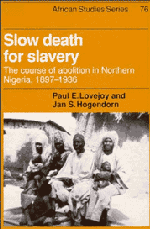Book contents
- Frontmatter
- Contents
- List of maps
- List of tables
- Preface
- 1 Slavery and the British conquest of Northern Nigeria
- 2 Fugitive slaves and the crisis in slavery policy
- 3 The debate on legal-status abolition
- 4 Emancipation and the law
- 5 Upholding proprietary rights to land
- 6 The role of taxation in the reform of slavery
- 7 The colonial economy and the slaves
- 8 The persistence of concubinage
- 9 Legal-status abolition: the final phase
- Appendix: Court records of slaves issued certificates of freedom
- Notes
- Glossary
- Bibliography
- Index
- Title in the series
Appendix: Court records of slaves issued certificates of freedom
Published online by Cambridge University Press: 03 May 2011
- Frontmatter
- Contents
- List of maps
- List of tables
- Preface
- 1 Slavery and the British conquest of Northern Nigeria
- 2 Fugitive slaves and the crisis in slavery policy
- 3 The debate on legal-status abolition
- 4 Emancipation and the law
- 5 Upholding proprietary rights to land
- 6 The role of taxation in the reform of slavery
- 7 The colonial economy and the slaves
- 8 The persistence of concubinage
- 9 Legal-status abolition: the final phase
- Appendix: Court records of slaves issued certificates of freedom
- Notes
- Glossary
- Bibliography
- Index
- Title in the series
Summary
The number of court cases involving slaves rose slowly in the early years of colonial rule (Table A.1). A total of 2,161 had passed through the courts by 1905; the number was only 7,199 by 1909. Thereafter there was a dramatic increase. In 1914, the total reached 35,814, of whom 28,615 (79.9 percent) appeared in court after 1909. By 1919, at least 69,785 slaves had been issued certificates of freedom, and by the end of 1929, the number was approximately 102,750 (Table A.2). By then the number of cases fell off considerably and by the early 1930s there were almost no cases.
The detailed returns for 1905–1906 (Table D.1) and the more general figures for 1901–1906 that appeared in the Annual Report for 1905–1906 (Table A.3) can be taken as a base from which to measure subsequent change. There are important differences between these sets of data. The sample of 584 cases reported for 1905 and 1906 (and a few cases dating back to 1904) have the disadvantage of under-representing Kano, Katsina, Sokoto, Gwandu, and several smaller emirates near these major centers. Undoubtedly, the great majority of slaves were held in these emirates. Zaria, Bauchi, and Yola, which were also important emirates, are well represented, however. There is no reason to suppose that these emirates differed significantly from the central emirates in terms of the profile of the slave population.
- Type
- Chapter
- Information
- Slow Death for SlaveryThe Course of Abolition in Northern Nigeria 1897–1936, pp. 287 - 304Publisher: Cambridge University PressPrint publication year: 1993

